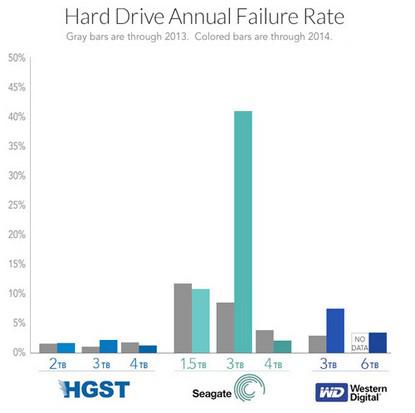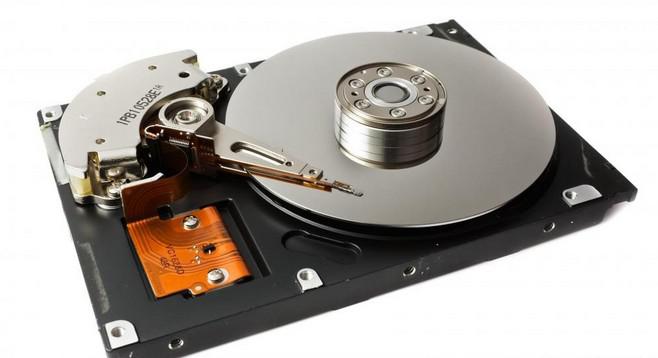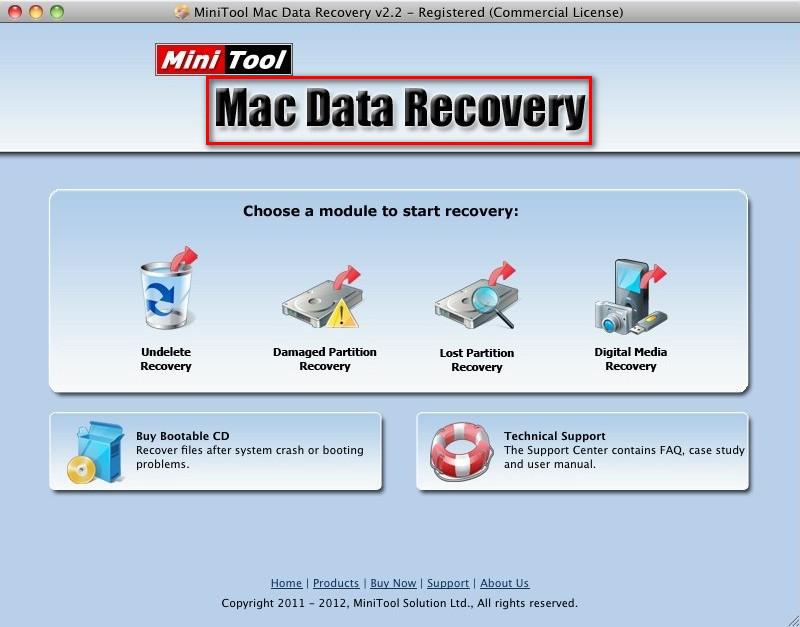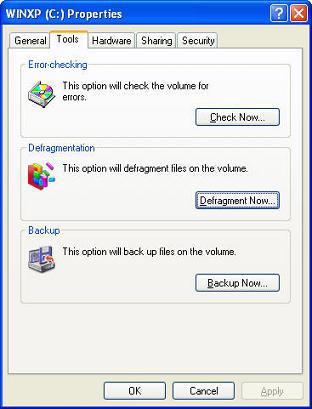
But since internal hard drives and external hard drives are widely used, hard drive data loss occurs frequently. And thus, methods for achieving hard drive recovery successfully are demanded. We guess it’s easy to understand this fact: the possibility of losing data in a poor-quality hard drive is much larger than that in a high-quality hard drive. Well, how can we choose a hard drive with high quality? Here are some parameters that can determine a good hard drive.
How to Define a Good Hard Drive
By looking at the following aspects, you can distinguish good hard drives from the bad ones.- Capacity: it is one of the most important parameters of hard drive,
since hard drive acts as the main storage device for computer. The unit
of hard drive capacity is megabytes (MB) or gigabytes (GB).
1GB equals to 1024MB, while 1TB equals to 1024GB. However, the hard
drive manufacturers usually take 1GB as 1000MB when defining the hard
drive capacity. That explains why we see a smaller capacity in BIOS or
when formatting the hard drive.
As we have said before a hard drive is made up of one or more discs, so hard drive capacity depends a lot on the number and capacity of platter. The so-called platter capacity refers to the capacity of a single disc; the larger the platter capacity is, the lower the unit cost is and the shorter the average access time is. For users, the capacity of hard drive will never be too much for them. - Transfer rate: it is actually the data read & write speed of hard drive and its unit is megabytes per second (MB/s). Hard drive transfer rate includes internal transfer rate and external transfer rate.
Internal transfer rate is also known as sustained transfer rate; it reflects the of the hard disk performance when buffer is unused and mainly depends on the rotational speed of hard drive. External transfer rate is also called burst data transfer rate or interface transfer rate; it reflects the data transmission speed between system bus and the hard drive buffer and is related to interface type and size of cache memory. - Cache: it is indeed a memory chip on the hard drive controller;
having extremely fast access speed, cache is the buffer between internal
memory and external interface. Data need to be exchanged constantly
between hard drive and memory when hard drive access fragmentary data.
So if there’s a large cache, it can be used to set those bits and pieces
of data temporarily, greatly reducing the outer system load and
improving data transmission speed.

- Rotational speed: undoubtedly, rotational speed is the most striking
performance parameter of hard drive except for capacity. Whenever a
hard drive appears on the market, its rotational speed will be
absolutely involved in the promotional materials.
It is actually the rotational speed of motor shaft placed in hard drive and also refers to the maximum number of revolutions that the hard drive platter can complete in one minute. Rational speed is one of the key factors that determine the internal hard drive transfer rate. The hard drive rational speed is expressed by revolutions per minute (RPM). All in all, rational speed has a great impact on the instantaneous and sustained transmission speed of hard drive. - Average access time: it refers to the time required by magnetic head to reach the target track from the starting position and find the sector in which the data we need to read/write locate. The hard drive latency means that the magnetic head has already reached the target track, but it still have to wait for the target data sector to rotate to the position under the head before it can finally read data. As a result, reflecting the read and write speed of hard drive, the average access time equals to the average seek time plus average latency time.
By the way, the interface type of hard drive also plays a great role in influencing the hard drive performance.
Types of Hard Drive Damage
Hard drive damage can be divided into different types according to different ways of classification. But generally, it is divided into two categories, which are hardware damage and logical damage. Hardware damage can be subdivided into four types: head component damage, control circuit damage, comprehensive damage and physical bad track.
1.Head component damage: it means that part of the magnetic head component has been damaged, resulting in part of or the entire head failing to read and write data normally. A lot of factors, such as dirty head, head abrasion, head cantilever deformation, magnetic coil damage and displacement could all be accused of when magnetic head component is damaged.
2.Control circuit damage: it means that a certain part of the circuit line in hard drive electronic circuit board is broken or become short circuit or some electrical components or IC chips are damaged. In those cases, the platter in hard drive is not able to rotate or seek track properly after hard drive was connected to power supply.
3.Comprehensive damage: it mainly refers to the various kinds of problems generated on hard drive because of some minor changes. Sometimes, aging problem will occur on part of the hard drive chip because of high temperature or other factors during using. Sometimes, minor changes or displacement may take place on hard drive shell, disc surface or spindle motor after the hard drive has been shaken. And in some other cases, flaws can be found in heat dissipation, friction and structure design.
Those reasons could lead to various unpleasant phenomena: unstable hard drive working performance, frequent data loss or logical error, big noise, low read and write speed, and so on.
4.Physical bad track: it represents the physical damage appeared on hard drive surface due to collision, magnetic head friction or other reasons.
However, logical damage includes track servo information error, system information area error and sector logical error (which is generally called logical bad track as well).
1.Tack servo information error: it refers to the situation where physical tracks can’t be accessed since the servo information of certain physical track has been damaged or become invalid.
2.System information area error: it means that the hard drive system information area fails to read data in some modules or complete the verification stage during the power-on and self-test process. Thus, the hard drive is not able to enter the preparation state. By the way, the system information area of hard drive is actually a system reserved area inside the hard drive and it has been subdivided into multiple modules to save a lot of hard drive default parameters, settings and internal control procedures.

3.Sector logical error: it indicates that some sectors will become invalid because of verification error (ECC or CRC), sector mark error (IDNF), address information error (AMNF), bad block mark error (BBM) and other reasons.
As you can see, there are many reasons that can lead to hard drive damage. The hard drive quality, the working conditions and performance of other devices in the entire computer system and the using methods are all among the possible causes for hard drive damage. So please be careful enough when you’re dealing with hard drive.
Solutions to Completing Hard Disk Recovery in Different Cases
As you can imagine, the solutions to different types of hard drives damage are different. Meanwhile, the hard drive recovery cost is also not the same in hard drive physical damage and logical damage. But is it possible and how to recover data from hard disk? Please read the following content.In the situation where your hard drive is damaged physically, you should try to clean the hard drive gently with special cleaning tools (this may repair the damage caused by too much dust or slight scratch). If this is not useful, you have no choice but to hire professional recovery service to help you. Of course, the disk recovery cost may be very high since specific tools and techniques will be involved. But it would be worth the money if they can get back the lost data that are crucial to you.
Fortunately, things would be much easier for you if the hard drive damage is only caused by logical damage, such as inappropriate operation and virus invasion. In this case, a piece of mighty and free hard disk recovery software will be enough for drives recovery. For example, MiniTool Power Data Recovery is an excellent choice.

Just download and install this free hard drive recovery software to computer to be well prepared for data recovery from hard drive. Then, open the program and put your cursor onto each module in the main interface to see its using range. Now, choose the most suitable one from those five functional modules on the basis of your actual needs and then click it to enter corresponding operating interface. You don’t need to be worried too much since the operation prompts in each interface will tell you what to do to carry out lost data recovery gradually.
However, if your system is crushed and you have no way to open the computer, you may as well use the bootable edition of MiniTool Power Data Recovery to access to damaged hard drive without system and then recover data from this hard drive by making use of a proper functional module.

If you’re running a Mac system, you need to turn to MiniTool Mac Data Recovery since both the free edition and bootable edition of MiniTool Power Data Recovery are designed for Windows platform. Then, the operating steps of file recovery on Mac are the same to that of Windows disk recovery.
Good Hard Drive Maintenance Decreases Hard Drive Damage Rate
Do you know what’s even better than the best disk recovery software? The answer is prevention. Instead of trying to find methods for finishing hard drive data recovery, users had better know how to well protect the computer hard drive. In this way, they don’t need any data recovery professionals to help them recover data from disk.There are exactly a large variety of factors that could lead to data loss and make users in need of hard drive recovery service. So users should get to know them well to achieve good hard drive maintenance.
- Dust: it’s evident that a hard drive could be damaged if serious dust accumulation is found on hard drive. First of all, the dust deposited on the circuit board of hard drive can seriously affect the heat dissemination of circuit board chip. Thus, the temperature of components on circuit board will rise, leading to chip overheating and burning. Secondly, the short circuit is likely to be caused if the dust absorbed moisture.
- Temperature: the working status and service life of hard drive is closely related to temperature. Clock frequency of crystal oscillator will be changed no matter the temperature is too high or too low and this will cause circuit component failure.
-
 Cooling fan: taking the cooling effect into account, many people have
their own computer hard drive installed with cooling fan. However, the
vibration of some low-grade fan is very strong during the working time
and this vibration can be passed to hard drive. And it will definitely
have a bad impact on the service life of hard drive in the long run.
Cooling fan: taking the cooling effect into account, many people have
their own computer hard drive installed with cooling fan. However, the
vibration of some low-grade fan is very strong during the working time
and this vibration can be passed to hard drive. And it will definitely
have a bad impact on the service life of hard drive in the long run. - Optical drive: when the optical disc is rotating at a high speed in the optical drive, the optical drive vibration will lead to computer chassis resonance so as to affect the working of hard drive. Meanwhile, this kind of rotation will certainly raise the temperature of optical dive thus changing the hard drive working temperature.
- Static electricity: in the course of operating computer hardware, a lot of people tend to hold the hard drive directly with hand. However, in dry weather, thousands of volts of static electricity may be accumulated on human hands and it may penetrate the circuit board chip, and finally result in hard drive failure.
- Power supply: if there is something wrong with the power supply while hard drive is performing write and read operation, this hard drive can be destroyed in just a moment.
- Magnetic field: if the hard drive is subjected to magnetic interference of the external environment, hard drive data loss is easy to be brought since hard drive is a device recording data by relying on magnetic media. So please put your hard drive away from magnetic environment as far as possible.
-
 Defragmentation: it is a common sense that the hard drive speed will
slow down and the magnetic track may be damaged if there are too many
junk files on hard drive. This is a reason why computer users are
suggested to defragment hard drive regularly. But remember, please don’t
clean up your hard drive too often since it will also reduce the
service life of hard drive and may lead to data loss due to wrong
operation.
Defragmentation: it is a common sense that the hard drive speed will
slow down and the magnetic track may be damaged if there are too many
junk files on hard drive. This is a reason why computer users are
suggested to defragment hard drive regularly. But remember, please don’t
clean up your hard drive too often since it will also reduce the
service life of hard drive and may lead to data loss due to wrong
operation. - Virus prevention: as you can imagine, virus is one of the biggest threats to files stored on hard drive. Therefore, users shouldn’t open any files or links until they can finally confirm its safety. Besides, users have to take measures to kill virus immediately after it has been detected.
Things You Shouldn’t Do
- Never cut off the power supply whether the computer is in operation or in startup and shutdown phase.
- Don’t take out the hard drive and put it in any place arbitrarily.
- Avoid performing any operation to computer when you’re not sure about what results it will bring.
- Please don’t get into panic and keep operating on computer after you found data loss occurs on hard drive.
- Try not purchasing any poor-quality computer accessories.
Believe it or not, as long as you pay enough attention to what we have mentioned here, you can avoid computer hard drive damage and hard drive recovery effectively.
No comments:
Post a Comment